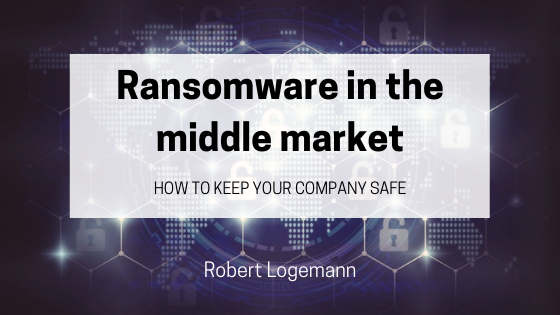Of all the threats spawned by high-level modern technology, ransomware is objectively one of the most nefarious; it is the first type of viral internet attack that generates revenue for those orchestrating it. Victims are commonly threatened with harm — usually, as it pertains to important or sensitive data — and forced into paying a ransom to avoid damage.
Terrifying and unfathomable as this notion may be, ransomware is an enduring reality in the professional world (despite reported declines in attacks during 2018). Specifically, it has become a glaring threat to middle market companies, some of which are viewed as easy targets due to a number of potential vulnerabilities.
That said, here are a few ways your company can fortify itself against ransomware attacks.
Self-assess
Middle market leaders are expected to uphold a reasonable level of confidence in their companies’ IT infrastructure, but they must also hold it to a high standard and never assume it is impenetrable. The environment in which these attacks occur is ever-changing, and that warrants an equally fluid and self-aware internal protocol.
As reported by IndustryWeek, many middle market companies have fallen victim to ransomware due to ruinous optimism; they simply have not exercised proper foresight. Nearly all companies today, no matter how big or small, must invest in regular cybersecurity maintenance, auditing their systems for exploitable weaknesses.
For those currently lacking it, cyber insurance also stands as an invaluable asset, as it can help establish a clearer protocol for ransomware attacks. In these situations, many insurance providers cover the cost of ransom, and some even handle the negotiation process, alleviating potential stress for the victim. Insurance plans are generally inexpensive and can potentially be the difference between quick recovery and long-lasting damage.
Consider company storage
Branching off the broad cyber auditing concept, it can be hugely beneficial to address and potentially revamp your company’s current data storage layout. Ransomware survival hinges on quick and effective attack recovery, and with potentially large amounts of company data on the line, a multifaceted storage makeover can stand as a crucial asset.
Perhaps consider investing in a cloud-based storage concept, if you haven’t already; this will add layers to your company’s data security, creating separate storage destinations where you can back up data and make it easier to relocate in wake of an attack (all while making it harder for attacks to hold master versions of the data in question, ultimately taking the wind out of the threat from the beginning).
Principles outlined in the previous section also apply here; be sure to perform regular assessments of backed up data sectors, diversifying and periodically editing passwords so they are harder to decrypt. Just like burglars targeting poorly protected homes, ransomware attackers tend to select their victims based on noticeable vulnerabilities, and this must be considered for every facet of your company — down to its backmost defensive layers.
Revisit perspective
Perspective is crucial in a ransomware situation — in more ways than you may initially think. Consider, for instance, the attackers themselves; they may seem like unhinged villains with a quick trigger finger, but, while their character is clearly up for debate, the fact of the matter is that, in many cases, these individuals are trying to operate in an orderly, well-thought-out manner.
You could almost interpret ransomware as a morbid business transaction of sorts; attackers are typically focused solely on collecting their desired ransom and maintaining credibility, of sorts, in their market — not so much on savaging your company outright (though most are prepared to do so, should negotiations fall through). It is ill-advised to call an attacker’s bluff, but by understanding their raw intentions, it can be easier to diffuse attacks at an emotional level. Assuming necessary damage control measures have been put in place, this shift in perspective can complement your overall handling of the situation.
Educate, and never stop
Consistent infrastructural assessment is key in blocking ransomware attacks, but so is the equally consistent education of your company’s employees. This training can go as broad as best data protection practices to general rules of thumb at surface level (how to spot malicious emails, etc.). However, just like the auditing process, this education should never completely cease. Keep yourself aligned with changes and trends in ransomware activity, and make sure your training adapts to meet subsequent new challenges.
Ransomware, like its contemporary threats, is a chameleon of sorts; it has adapted to a number of efforts to identify and stop it, and it will seemingly continue to do so until we have found a way to permanently corner it. In the meantime, take the steps needed to shore up your company and maintain peace of mind.




